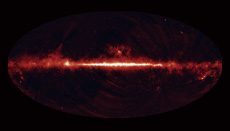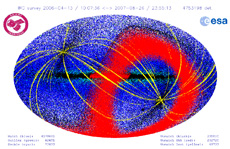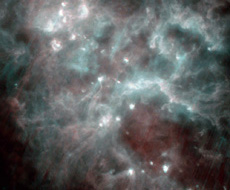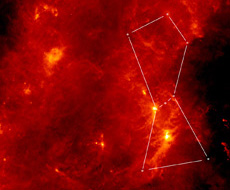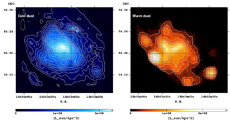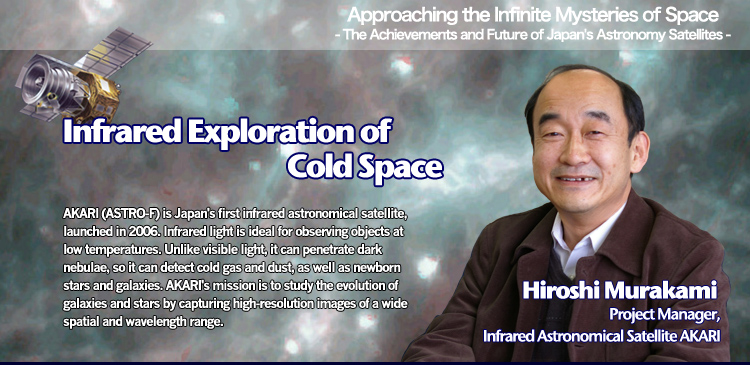
Q. Could you describe the major observations AKARI has made so far?
AKARI's major achievement to date is an all-sky survey. It has also made an additional 5,000 observations of specific areas and objects. It takes a long time to analyze such a large volume of data, and we have only been able to publish a few results so far. But here are some of the highlights:

AKARI has successfully mapped 94 percent of the entire sky using far-infrared light. The resolution far exceeds the infrared images taken in the 1980s by IRAS which is a satellite launched by the United States, the United Kingdom and the Netherlands. The new map shows the Milky Way, viewed edge-wise from the Earth, extending out from the center in both directions. The Galactic Center is the brightest area, crowded with dust and old, bright, red giant stars. In and around the bands are several bright regions that stretch across the galaxy. These are sites of active star formation, where interstellar dust, heated by newborn stars, emits strong infrared radiation. AKARI's all-sky map clearly shows the locations and the volume of these new star formations.
A team of analysts at the European Space Agency (ESA) has also plotted a map of celestial bodies contained in AKARI's all-sky map. They've identified over 500,000 galaxies and stars, but many other objects remain unidentified. It will be exciting to learn more about these objects, although some could be illusions created by cosmic rays hitting AKARI's infrared sensor. The ones marked on the map in red are the ones we think are suspicious. AKARI even unexpectedly captured geostationary satellite as part of the map. Studying the map closely is a lot of fun. But right now the job is mainly separating the wheat from the chaff - the true objects from the false.

AKARI has successfully captured moments when stars are born. A massive star emits as and strong ultraviolet radiation. This ultraviolet radiation and the supernova explosion when the star dies sweep away the surrounding interstellar gas and create a hollow in space. The gas around the hollow is compressed and becomes dense, which leads to the formation of new stars. When a massive star is born, it again sweeps away the surrounding gas, and the resulting compression leads to further star formation. This chain reaction of birth and death is repeated over and over.
In the Cygnus Milky Way, in regions that appear bright in infrared, celestial bodies that are 3,000 to 10,000 light years from our solar system appear to be superimposed. Observed by AKARI, these luminous bodies are themselves the sites of formation of massive stars. AKARI's images also include dark regions that look like large hollows. Here, star clusters formed and the intense light swept away the surrounding gas and dust. I expect that more stars will form there in the future.
Near the constellation Orion, AKARI observed distribution of expelled interstellar gas, sites where stars were forming, as well as the very beginning of star formation. Particularly bright regions indicate the sites of successive formation of many stars, and strong infrared emissions from dust heated by starlight. These are the first-ever infrared observations of such a wide scope with a high resolution.

One of AKARI's discoveries is that in the spiral galaxy M101, stars form differently than in other galaxies. The galaxy M101 is located approximately 24 million light years from Earth, and is twice as large as the Milky Way. In spiral galaxies, we believe that stars form more actively the closer they are to the Galactic Center. In galaxy M101, however, star formation is more active at its edge. By studying the distribution of warm and cold dust in the galaxy, we found that the accumulation of warm dust is greater near its edge. We know that dust is heated by newborn stars, so from this it seems that star formation is significantly more active at the galaxy's edge.
But how can we explain this phenomenon? We assume that it is a result of the galaxy's previous gravitational interaction with its companion galaxy. It has been observed that hydrogen gas, drawn by tidal forces of the companion galaxy, is pouring over the edge region of M101, which potentially has something to do with the occurrence of star formation. But we do not know why hydrogen gas is observed only at the boundary. AKARI has been observing other galaxies, too, and I think that analyzing their data will help us to better understand the mechanism of galactic star formation.
